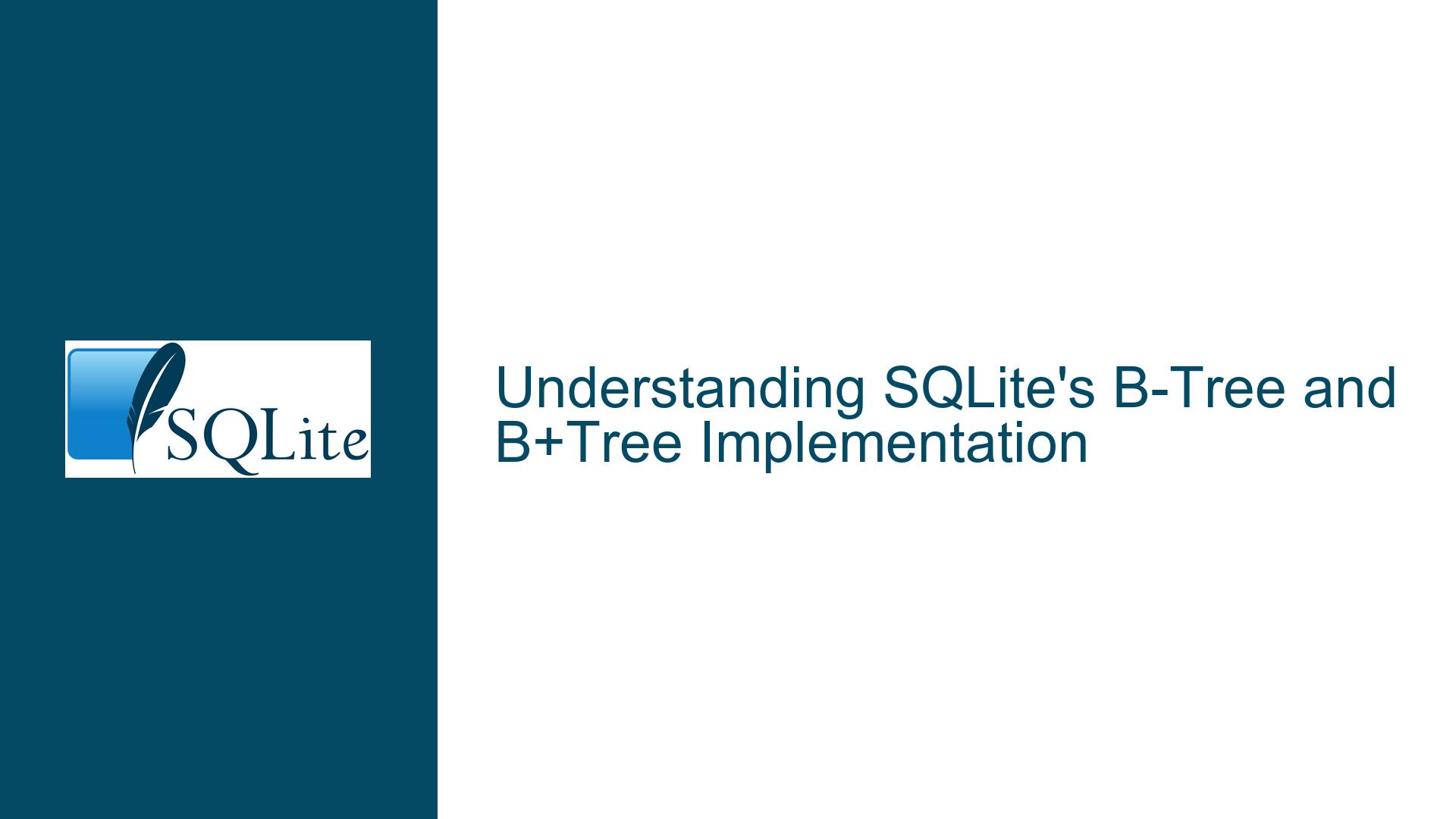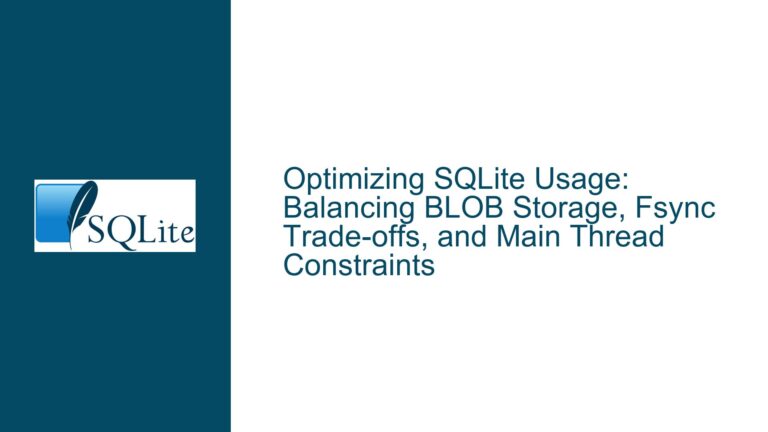SQLite’s B-Tree and B+Tree Implementation
SQLite’s B-Tree and B+Tree: A Deep Dive into Index and Table Structures
SQLite, a widely-used embedded relational database management system, employs a sophisticated data structure known as the B-Tree for organizing and managing data. However, there is often confusion about whether SQLite uses a traditional B-Tree, a B+Tree, or a combination of both. This post aims to clarify the nature of SQLite’s B-Tree implementation, focusing on the differences between Index B-Trees and Table B-Trees, and how they relate to the broader concepts of B-Trees and B+Trees.
SQLite’s B-Tree Architecture: Index B-Trees vs. Table B-Trees
SQLite’s storage engine is built around two primary types of B-Trees: Index B-Trees and Table B-Trees. These structures are central to how SQLite organizes and retrieves data. Index B-Trees are used to manage database indexes, which are essential for speeding up query performance. Table B-Trees, on the other hand, are responsible for storing the actual table data. Both types of B-Trees share some common characteristics but also have distinct features that make them suitable for their respective roles.
Index B-Trees in SQLite are designed to store only keys, without any associated payload. This design allows for efficient searching and retrieval of index entries, which are used to quickly locate rows in the associated table. The keys in an Index B-Tree are typically derived from the columns that are indexed, and the structure of the tree ensures that these keys are stored in a sorted order, enabling fast lookups.
Table B-Trees, in contrast, store both keys and payloads. The payload in a Table B-Tree consists of the actual row data, which includes the values for all columns in the table. The keys in a Table B-Tree are typically the rowids, which are unique identifiers for each row in the table. The combination of keys and payloads in Table B-Trees allows SQLite to efficiently store and retrieve entire rows of data.
The distinction between Index B-Trees and Table B-Trees is crucial for understanding how SQLite manages data. While both types of B-Trees are based on the same underlying principles, their specific implementations are optimized for their respective tasks. Index B-Trees are optimized for fast key-based lookups, while Table B-Trees are optimized for storing and retrieving large amounts of data.
The B+Tree Debate: Are SQLite’s B-Trees Actually B+Trees?
The question of whether SQLite’s B-Trees are actually B+Trees is a common source of confusion. To address this, it is important to understand the differences between B-Trees and B+Trees. A B-Tree is a self-balancing tree data structure that maintains sorted data and allows for efficient insertion, deletion, and lookup operations. Each node in a B-Tree can contain multiple keys and pointers to child nodes, and the tree is balanced in such a way that all leaf nodes are at the same level.
A B+Tree, on the other hand, is a variant of the B-Tree that is optimized for use in databases and file systems. In a B+Tree, all keys are stored in the leaf nodes, and the internal nodes contain only keys and pointers to child nodes. This design allows for more efficient range queries, as all the data is stored in the leaf nodes, which are linked together in a sequential manner.
In the context of SQLite, the distinction between B-Trees and B+Trees is somewhat blurred. SQLite’s B-Trees share some characteristics with B+Trees, particularly in the way they handle keys and payloads. For example, in a Table B-Tree, the keys (rowids) and payloads (row data) are stored together in the leaf nodes, which is similar to how data is stored in a B+Tree. However, SQLite’s B-Trees also have some features that are more characteristic of traditional B-Trees, such as the ability to store multiple keys and pointers in internal nodes.
The debate over whether SQLite’s B-Trees are actually B+Trees is largely academic. In practice, SQLite’s B-Trees are highly optimized for their specific use cases, and the distinction between B-Trees and B+Trees is not particularly relevant to most users. What is important is that SQLite’s B-Trees provide efficient and reliable storage and retrieval of data, regardless of whether they are technically B-Trees or B+Trees.
Optimizing SQLite’s B-Tree Performance: Best Practices and Techniques
Given the central role that B-Trees play in SQLite’s storage engine, it is important to understand how to optimize their performance. There are several best practices and techniques that can be employed to ensure that SQLite’s B-Trees operate efficiently, particularly in high-performance or resource-constrained environments.
One key consideration is the size of the B-Tree nodes. In SQLite, the size of the B-Tree nodes is determined by the page size, which can be configured using the PRAGMA page_size command. Larger page sizes can improve performance by reducing the number of I/O operations required to read or write data, but they can also increase memory usage. Conversely, smaller page sizes can reduce memory usage but may result in more I/O operations. The optimal page size depends on the specific requirements of the application, but a common recommendation is to use a page size of 4096 bytes, which is the default in most SQLite installations.
Another important factor is the use of indexes. Indexes are critical for speeding up query performance, but they also add overhead to the database. Each index is stored as an Index B-Tree, which means that every insert, update, or delete operation on a table must also update the corresponding Index B-Tree. This can lead to increased write latency and reduced overall performance, particularly in write-heavy workloads. To mitigate this, it is important to carefully consider which columns to index and to avoid creating unnecessary indexes.
In addition to optimizing the size of B-Tree nodes and the use of indexes, there are several other techniques that can be used to improve the performance of SQLite’s B-Trees. One such technique is the use of the PRAGMA journal_mode command to configure the journaling mode. The journaling mode determines how SQLite handles transactions and ensures data integrity in the event of a crash. The default journaling mode is DELETE, which is suitable for most applications, but other modes such as WAL (Write-Ahead Logging) can provide better performance in certain scenarios.
Another technique is the use of the VACUUM command to optimize the database file. The VACUUM command rebuilds the entire database file, which can help to reduce fragmentation and improve performance. This is particularly useful after a large number of insert, update, or delete operations, as these operations can lead to fragmentation within the B-Tree structures.
Finally, it is important to monitor the performance of SQLite’s B-Trees and to make adjustments as needed. SQLite provides several tools for monitoring performance, including the EXPLAIN QUERY PLAN command, which can be used to analyze the execution plan of a query and identify potential bottlenecks. By regularly monitoring performance and making adjustments as needed, it is possible to ensure that SQLite’s B-Trees continue to operate efficiently over time.
In conclusion, SQLite’s B-Trees are a critical component of its storage engine, and understanding their structure and behavior is essential for optimizing database performance. While there is some debate over whether SQLite’s B-Trees are technically B-Trees or B+Trees, the distinction is largely academic. What is important is that SQLite’s B-Trees are highly optimized for their specific use cases, and by following best practices and employing the right techniques, it is possible to ensure that they operate efficiently and reliably in a wide range of applications.





